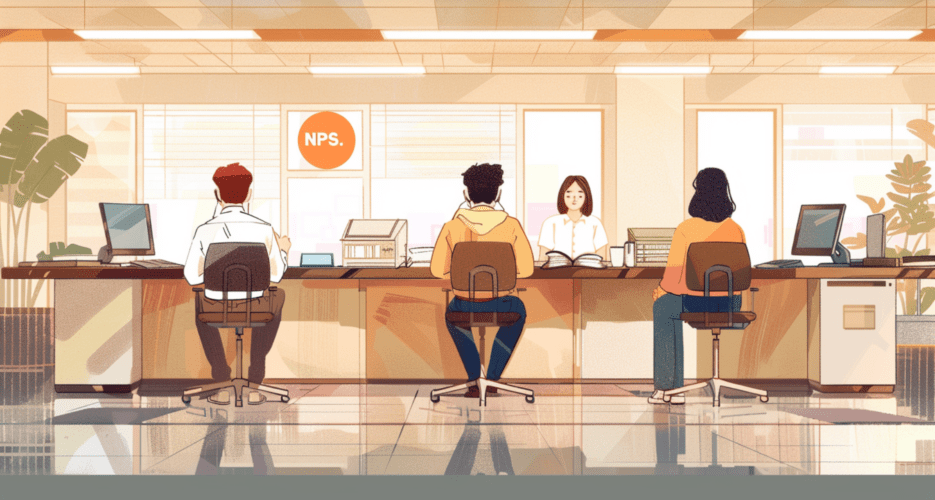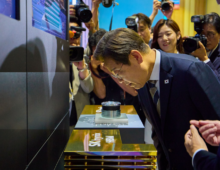|
Analysis Political deadlock hinders South Korea’s efforts to save its pension systemExperts warn of financial instability and societal disruption if the National Pension Service is not overhauled Joon Ha ParkJune 6, 2024  An illustration of people in the National Pension Service office | Image: Korea Pro Without substantial structural reforms, South Korea’s National Pension Service (NPS) could be in deficit by 2041 and risk depletion by 2055 due to the country’s rapidly aging population and shrinking workforce. This could potentially destabilize the nation’s capital markets and cause significant financial instability and societal disruption. In 2007, South Korea overhauled its pension system, requiring employers and employees to contribute 9% of the employee’s monthly earnings. By 2024, retirees turning 65 can expect to receive 42% of their wages as pension benefits. However, despite both major parties agreeing to increase the contribution rate to 13%, disagreements over the income replacement rate percentage and the approach to reform — parametric versus structural — have hindered progress on this issue. Parametric reforms involve adjusting numerical values within the existing framework, such as contribution rates or income replacement rates, to stabilize finances. In contrast, structural reforms entail fundamental changes to the system, such as altering payment structures or transitioning between different pension schemes. Experts emphasize the necessity of implementing parametric reforms as an initial step while preparing for more comprehensive structural changes to address the ailing pension system’s long-term sustainability. BOGGED DOWN BY POLITICS Pension reform has been a constant in President Yoon Suk-yeol’s policy pledges since 2022. In May, Yoon stated his intention to raise the basic pension payment level to $290 (400,000 won) within his term. However, prolonged negotiations between the ruling People Power Party (PPP) and the main opposition Democratic Party (DP) over adjustments to contribution rates and income replacement rates have hindered progress. In Oct. 2022, the National Assembly established a special committee on pension reform through a bipartisan agreement. The plan was for a civilian advisory committee of experts to draft a reform proposal for the government to finalize by Oct. 2023. However, differing opinions within the advisory committee on enhancing financial stability and ensuring retirement income security prolonged discussions and delayed reform. The DP has pushed for an initial parametric reform to address urgent issues, while the PPP has called for a comprehensive reform that includes both parametric and structural changes. In Oct. 2023, the Ministry of Health and Welfare presented the Fifth Comprehensive National Pension Draft. However, it left out specific figures or directions on key reform issues, such as the contribution rate and income replacement rate, shifting the reform decision back to the National Assembly.  South Korean President Yoon Suk-yeol (right) meets with main opposition Democratic Party leader Lee Jae-myung, April 29, 2024 | Image: ROK Presidential Office LACK OF CONSENSUS The special committee reached a consensus in May 2024 to raise the contribution rate from 9% to 13% to address the issues of financial stability. However, disagreements persisted over the income replacement rate, with the DP advocating for a 45% rate and the PPP proposing a 43% rate or a conditional 44% rate based on structural reforms. This disagreement left the reform bill in a stalemate. DP leader Lee Jae-myung expressed willingness to accept the PPP’s conditional 44% rate before the end of the 21st National Assembly and proposed a one-on-one meeting with the president to break the deadlock. However, the presidential office rejected Lee’s proposal, deeming it inappropriate for Yoon to hold talks with opposition party leaders when the National Assembly had not yet reached a decision. Oh Jong-heon, secretary general of the nongovernmental group National Action to Strengthen Public Pensions (NASPP), explained to Korea Pro that historically, pension reform involves the government proposing a plan and actively promoting it, with opposition parties offering counterpoints, thus reaching a compromise. However, Oh noted that in this case, the government passed responsibility to the National Assembly. “This led to the formation of a special committee on pension reform, which initially focused on parametric reforms. Later, the government and the PPP’s insistence on structural reforms derailed the process, resulting in further delays,” Oh told Korea Pro. Oh also highlighted that South Korea’s public pension spending, at less than 3% of its GDP, is significantly lower than that of European countries like Greece, Italy and France, which allocate around 13 to 15% of their GDP to public pensions. “Increasing government contributions to the national pension system, similar to the levels seen in Europe, could alleviate the financial pressures on subscribers and help ensure the long-term sustainability of the pension fund,” Oh said. BALANCING PARAMETRIC AND STRUCTURAL REFORMS Experts acknowledge that parametric reforms are crucial for achieving financial stabilization, but they also emphasize that structural reforms must swiftly follow to address systemic inefficiencies and ensure the long-term sustainability of South Korea’s pension system. “Discussions around pension reform have highlighted the necessity for both parametric and structural changes,” Oh of NASPP said. Oh suggested that stabilizing the NPS through parametric reforms, such as modifying the income replacement rate and premium rate, is an essential first step. According to Oh, stabilizing the NPS is critical before adjusting other pension schemes, as failing to do so could complicate and undermine the effectiveness of broader reforms. While parametric reforms offer a temporary solution, they cannot replace the need for comprehensive structural changes to address the deep-seated issues within South Korea’s pension system, said Shin Seung-ryong, an associate research fellow at the Korea Development Institute (KDI). Shin stressed that financial stability requires a substantial increase in the contribution rate and a reduction in the income replacement rate. He warned that focusing solely on financial adjustments without considering demographic shifts could reduce the system’s long-term efficiency. “A significant increase in insurance premiums now would burden current contributors and might drive them toward private pensions. This is the major drawback of parametric reforms,” Shin told Korea Pro. Oh Geon-ho, the policy committee chairman of the nongovernmental group My Welfare State, highlighted that increasing the contribution rate from 9% to 13% or 18% could help balance future income and expenditure but wouldn’t resolve the underlying structural problems that necessitate ongoing adjustments. He proposed structural reforms that could include providing a uniform basic pension to all eligible individuals, with additional support for those in need. He also suggested making pension redistribution benefits directly proportional to an individual’s income level. “These reforms could enhance system equity and efficiency, addressing fundamental design flaws that parametric adjustments alone cannot fix,” Oh suggested. However, Oh of NASPP noted that structural reform in pensions is particularly challenging due to disparities between people who benefit from special occupational pensions — such as civil servants and military personnel — and general occupational pensions. Oh noted that this disparity is challenging to resolve. For instance, former President Park Geun-hye failed to reform pensions for the country’s civil servants in 2015 due to strong opposition from affected groups. To achieve comprehensive pension reform, the NPS must first undergo parametric reform to stabilize its contributions and benefits. This provides a foundation to adjust other pension schemes, ensuring a more manageable and effective reform process,” Oh said.  Main opposition Democratic Party leader Lee Jae-myung (center) holds a press conference on pension reform, May 25, 2024 | Image: Democratic Party of Korea A COMPREHENSIVE APPROACH Experts emphasized to Korea Pro the necessity of adopting a comprehensive approach to mitigate the impact of South Korea’s aging population on its pension system. They stressed the urgent need to build momentum for reforming the NPS through extensive social dialogue and legislative actions aimed at ensuring sustainable old-age security and fiscal stability. Shin of the KDI emphasized the government’s role in advancing meaningful pension reform, stating that “the government must take proactive steps and prioritize sustainable, structural reforms that minimize citizens’ financial burdens while maximizing benefits.” He underscored the importance of utilizing the current pension fund effectively before it faces depletion. He further emphasized the need to design reforms that secure the financial future of younger generations by aligning their contributions and accrued benefits. Oh Jong-heon of NASPP advocated for incremental progress, cautioning against aiming for overly ambitious reforms that could lead to further delays. “Practical, step-by-step reforms can lay the groundwork for more comprehensive changes down the line,” he said. Oh Geon-ho of My Welfare State stressed the need for expanded social discourse alongside legislative deliberations to foster legitimacy and acceptance of parliamentary decisions on pension reform. He identified raising contribution rates and increasing basic pension benefits as urgent tasks that require collective action. However, Oh of NASPP expressed skepticism about the National Assembly and the government’s ability to deliver a satisfactory reform plan. “Given the hyperpartisan political climate, addressing structural reforms will be even more challenging,” he said. Edited by John Lee Without substantial structural reforms, South Korea’s National Pension Service (NPS) could be in deficit by 2041 and risk depletion by 2055 due to the country’s rapidly aging population and shrinking workforce. This could potentially destabilize the nation's capital markets and cause significant financial instability and societal disruption. In 2007, South Korea overhauled its pension system, requiring employers and employees to contribute 9% of the employee’s monthly earnings. By 2024, retirees turning 65 can expect to receive 42% of their wages as pension benefits. Get your
|
|
Analysis Political deadlock hinders South Korea’s efforts to save its pension systemExperts warn of financial instability and societal disruption if the National Pension Service is not overhauled  Without substantial structural reforms, South Korea’s National Pension Service (NPS) could be in deficit by 2041 and risk depletion by 2055 due to the country’s rapidly aging population and shrinking workforce. This could potentially destabilize the nation's capital markets and cause significant financial instability and societal disruption. In 2007, South Korea overhauled its pension system, requiring employers and employees to contribute 9% of the employee’s monthly earnings. By 2024, retirees turning 65 can expect to receive 42% of their wages as pension benefits. © Korea Risk Group. All rights reserved. |











